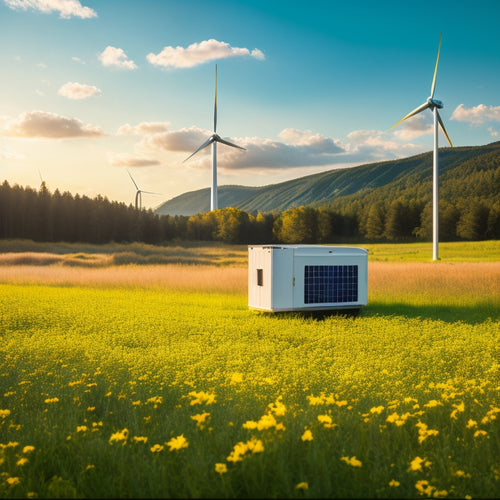
Pro Tips for Charging on the Trail With Solar Panels
Share
When you're charging on the trail with solar panels, focus on efficiency and portability. Choose high-efficiency monocrystalline panels that are lightweight and easy to set up. Always check weather forecasts—clear days maximize energy capture. Position your panels to catch the most sun throughout the day. If you're backpacking, consider folding panels for easy transport. Remember, this eco-friendly option not only cuts costs long-term but also elevates your energy independence while exploring remote areas. With the right setup, you'll reduce concerns about power availability and enhance your outdoor experience. Learn how to choose the perfect solar setup for your expeditions!
At a Glance
- Choose high-efficiency solar panels, such as monocrystalline, for compact design and optimal energy output during outdoor activities.
- Evaluate the weight and size of solar panels for portability; folding panels are great for backpackers, while rigid panels suit stationary setups.
- Monitor weather forecasts to optimize solar charging, as clear days yield the best energy capture, while cloud cover reduces efficiency.
- Position solar panels correctly to maximize sunlight exposure throughout the day, enhancing energy independence on the trail.
- Maintain your solar equipment regularly to ensure efficient energy capture and long-term performance while exploring remote areas.
Eco-Friendly Energy Source
Solar energy is a revolutionary development for outdoor enthusiasts like you, offering a clean and sustainable power source. By utilizing the sun's rays, you can keep your devices charged without harming the environment.
With features like high-efficiency solar panels and durable designs, modern solar power banks guarantee you have reliable energy during your expeditions.
Let's examine the benefits of solar energy and how to choose the right panel for your energy needs and off-grid solutions.
Benefits of Solar Energy
Utilizing solar energy offers a wealth of benefits, making it an increasingly popular choice for eco-conscious individuals. One of the most persuasive advantages is its minimal environmental impact. By capturing the sun's power, you're reducing your reliance on fossil fuels and lowering greenhouse gas emissions, contributing to a cleaner planet.
Thanks to solar technology advancements, solar panels have become more efficient and portable than ever. You can easily pack lightweight solar chargers on your trail excursions, ensuring you stay connected without harming nature. This independence allows you to investigate remote areas while maintaining access to your devices, enhancing your freedom in the great outdoors.
Moreover, solar energy is a renewable resource, meaning it won't run out as long as the sun shines. This long-term sustainability aligns perfectly with a lifestyle focused on conservation and responsibility.
As you adopt solar power, you're not just making a smart choice for your tech; you're also playing a part in preserving the environment for future generations.
Choosing the Right Panel
When selecting a solar panel for your outdoor excursions, it's essential to evaluate factors like size, weight, and output efficiency. You want a panel that's lightweight and portable, allowing you to carry it effortlessly in your backpack. Different solar panel types, such as monocrystalline, polycrystalline, and thin-film, each offer unique benefits. Monocrystalline panels are generally more efficient and compact, making them ideal for limited space.
To help you make the right choice, consider the following table:
| Solar Panel Type | Charging Capacity (Watt) |
|---|---|
| Monocrystalline | 100-200 |
| Polycrystalline | 80-160 |
| Thin-film | 50-120 |
| Foldable Panels | 20-60 |
| Backpack Panels | 10-30 |
Your ideal panel should match your charging capacity needs while being easy to set up. Don't forget to check for durability and weather resistance, as you'll want your gear to withstand the elements. With the right solar panel, you can enjoy the freedom of the outdoors while keeping your devices charged.
Cost-Effective Long-Term Investment
When you consider solar panels for your outdoor escapades, think about the initial investment compared to the long-term savings.
While the upfront cost might seem steep, the energy savings you'll enjoy over time can make it a smart choice.
Regular maintenance and cycle management can further enhance your system's performance, ensuring you get the most out of your investment.
You'll not only save money but also gain the freedom to charge your devices anywhere you go.
Initial Investment Considerations
Investing in solar panels for your outdoor outings can seem intimidating at first, but it's crucial to view it as a cost-effective long-term solution. When you think about budget planning, consider the initial costs versus the freedom solar energy provides during your journeys. Instead of constantly buying disposable batteries or relying on grid power, a solar setup can serve you for years.
Focus on equipment durability as you make your choices. Investing in high-quality solar panels and accessories means you won't need to replace them frequently, saving you money in the long run. Look for products with solid warranties and reviews that highlight their resilience in various outdoor conditions.
Moreover, factor in your unique journey style. Are you a weekend warrior, or do you take extended treks? Your usage will influence your initial investment, so pick a system that matches your needs.
While the upfront cost might feel steep, think about how much you'll save over time. Ultimately, a reliable solar setup can give you the freedom to venture into remote areas without worrying about charging—making it worth every penny.
Energy Savings Over Time
Understanding the long-term savings that come with solar panels can be a game changer for outdoor enthusiasts. By embracing solar energy, you're not just investing in a charging solution; you're committing to a more sustainable lifestyle that can considerably reduce your energy costs over time.
Once you adapt your energy habits and optimize your usage patterns, the savings really start to add up.
Consider how much you currently spend on batteries, fuel, or grid power for your trips. With solar panels, those costs diminish as you utilize the sun's free energy. You'll find yourself less reliant on traditional power sources, allowing you to venture farther and longer without the worry of running out of juice.
The initial investment in quality solar gear may seem intimidating, but once you factor in the money saved on replacements and recharges, it becomes clear that you're making a cost-effective long-term investment.
Imagine spending more time in nature and less time worrying about power. With solar panels, you're not just charging devices; you're charging your escapades and enhancing your freedom on the trail.
Panel Efficiency Ratings
When you're choosing a solar panel for your outdoor excursions, efficiency ratings are vital. They tell you how well a panel converts sunlight into usable power, which can affect your charging experience on the trail.
Higher efficiency ratings result in more energy capture and power production, making them ideal for limited space. Several factors, like temperature and panel angle, can influence performance, so understanding these elements helps you make a smarter choice.
Additionally, consider the higher upfront costs associated with efficient panels, as they often yield greater long-term savings.
Importance of Efficiency
Efficient solar panels are essential for maximizing your energy output on the trail. When you're out exploring, you want to guarantee that every ray of sunlight is converted into usable power. That's where panel efficiency ratings come into play.
Higher efficiency means more energy generated from the same amount of sunlight, allowing you to charge your devices faster and more effectively.
With advancements in solar panel technology, you now have options that can easily fit into your backpack without sacrificing performance.
When choosing your panels, pay attention to their efficiency ratings—look for those above 20% for ideal results. This will drastically impact your charging strategies, enabling you to power up your gear even on cloudy days or during shorter daylight hours.
Factors Affecting Performance
Several key factors can greatly impact the performance of solar panels on your outdoor excursions. Understanding these elements will help you maximize your energy capture, keeping your devices charged and your journeys uninterrupted.
| Factor | Impact on Performance | Tips for Enhancement |
|---|---|---|
| Sunlight Availability | More sunlight means more energy | Choose clear days for charging |
| Weather Conditions | Clouds and rain reduce efficiency | Monitor forecasts before heading out |
| Panel Orientation | Angling panels toward the sun increases capture | Adjust often to follow the sun |
When hitting the trails, pay attention to sunlight availability and weather conditions. A rainy day can drastically limit what you can charge. Also, consider panel orientation—it's vital to position your panels correctly for ideal exposure. Finally, verify your solar setup has the right battery compatibility; not all solar panels work well with every battery type.
Selecting Based on Portability
When choosing a solar panel for your trail excursions, portability is key. A lightweight and compact design will guarantee you can easily carry your solar solution without compromising your mobility.
Additionally, consider the benefits of solar power systems that markedly reduce reliance on traditional fuel sources while providing a dependable energy source.
Think about whether you prefer folding panels for easy storage or rigid ones for durability—each option has its advantages!
Weight and Size Considerations
Considering load and dimensions is essential for anyone looking to incorporate solar panels into their outdoor excursions. You'll want to strike a balance between power output and portability. The right solar panel setup can enhance your expedition without encumbering you.
To help you make informed choices, consider this table:
| Feature | Considerations |
|---|---|
| Load Distribution | Aim for panels that distribute weight evenly in your pack. This makes carrying easier and prevents strain. |
| Size Optimization | Look for compact designs that fit snugly into your gear without taking up excessive space. |
When selecting solar panels, think about how you'll carry them. A lightweight, compact panel not only frees up your load but also gives you the flexibility to move freely. Remember, every ounce counts on the trail. Prioritize gear that enhances your experience without becoming a burden. By focusing on load distribution and size optimization, you'll enjoy your expedition with reliable power without compromising your freedom.
Folding vs. Rigid Panels
Which type of solar panel best suits your outdoor journeys: folding or rigid?
When considering portability, folding panels often take the lead. They're lightweight, compact, and easily fit in your backpack, making them ideal for hikers and campers who value freedom of movement. Plus, they're designed to withstand the rigors of the trail, offering decent panel durability.
On the other hand, rigid panels tend to provide faster charging speeds due to their larger surface area and better efficiency. If you're car camping or have a set location in mind, these panels can deliver a more powerful power source. However, their bulkiness can be a drawback when you're on the move.
Ultimately, the choice between folding and rigid panels comes down to your journey style. If you're trekking far and need something that won't weigh you down, go for a folding panel.
But if you're setting up base and need reliable power quickly, a rigid panel might be the way to go. Consider your priorities, and choose the panel that aligns best with your outdoor lifestyle.
Happy charging!
Higher Energy Independence Potential
When you're out on the trail, relying on solar panels can greatly enhance your energy independence.
With improved off-grid power, you won't have to worry about finding a charging station or running out of battery life.
Instead, you can utilize the sun's energy, giving you the freedom to investigate remote areas without limitations.
Enhanced Off-Grid Power
Utilizing the power of the sun while you're out on the trail enhances your off-grid experience and boosts your energy independence. With the right solar panels and charging strategies, you can capture clean energy to power your devices without relying on traditional grids.
Envision yourself camping in a remote area, free from the chaos of daily life, knowing you've got energy at your fingertips.
To maximize your solar efficiency, focus on proper solar panel maintenance. Keep your panels clean and free from debris, ensuring they capture the sun's rays effectively.
Regular inspections will help you identify any wear and tear, so you can tackle issues before they impact your energy supply.
Incorporate smart charging strategies into your routine. Charge your devices during peak sunlight hours, and consider using a portable power bank for extra energy storage.
This way, you can keep your gear running smoothly, whether it's your GPS, camera, or other essential electronics.
Frequently Asked Questions
How Do Solar Panels Perform in Cloudy Weather?
Solar panels still generate power in cloudy conditions, but their solar efficiency drops considerably. You'll notice less energy production, so it's smart to supplement with battery storage or alternative charging methods during overcast days.
Can I Charge Multiple Devices Simultaneously With One Solar Panel?
Imagine basking in the sun while your devices charge. With the right solar panel capacity, you can charge multiple devices simultaneously, but charging efficiency may vary. Choose wisely to maximize your outdoor freedom.
What Is the Ideal Angle for Solar Panels on the Trail?
To maximize solar panel orientation, tilt your panel at an angle equal to your latitude for best sunlight exposure. Adjust it throughout the day to capture more sunlight, ensuring your devices charge efficiently while you investigate.
How Do I Maintain My Solar Panels While Camping?
Maintaining your solar panels while camping is essential; think of them as your lifeline! Use gentle cleaning techniques to remove dirt, and for storage tips, keep them in a cool, dry place when not in use.
Are There Specific Brands Recommended for Trail Use?
When choosing a solar panel for the trail, consider brands known for durability and weight efficiency. Look for lightweight options that withstand outdoor conditions, ensuring you stay powered up while enjoying your journey without extra burden.
Explore More
By embracing solar panels on your trail excursions, you're not just tapping into an eco-friendly energy source; you're investing in your freedom. Imagine powering your devices with the sun's rays while leaving a minimal footprint on nature. It's a choice that enables you to investigate further and longer without the burden of traditional energy sources. As you journey into the wild, remember: the sun is your ally, illuminating both your path and your commitment to sustainability.
Related Posts
-

How to Achieve a Zero-Waste Lifestyle for a Greener Tomorrow
To achieve a zero-waste lifestyle, start by adopting the principles of refusing, reducing, reusing, and recycling. Sw...
-

Sustainable and Eco-Friendly Generators for a Reduced Carbon Footprint
Sustainable and eco-friendly generators are perfect for cutting your carbon footprint and increasing energy efficienc...
-

Essential Hiking Lights for Safety and Fun
When you're hitting the trails, essential hiking lights are vital for safety and fun. A lightweight headlamp offers h...


